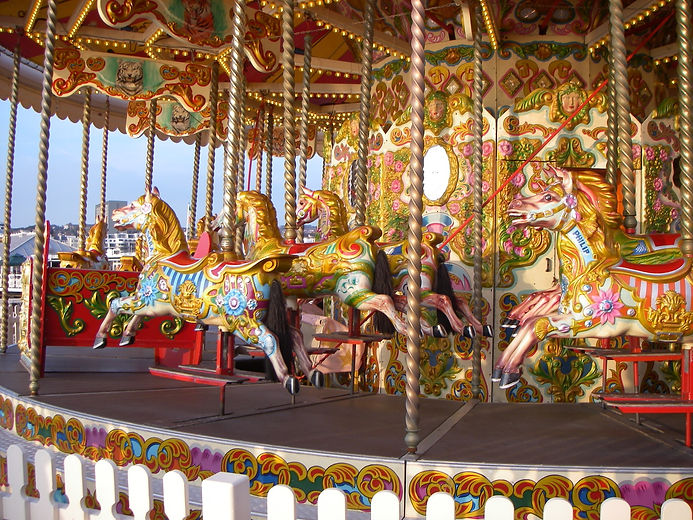




WELCOME TO An Entertainment Site for Scottish Country Dancers - Enjoy the curated selection of theme-related dances for celebrations and holidays, or find a dance associated with a special calendar day, or EVEN your own birthday!
Merry Go Round Day
Jul 25
Other Scottish Country Dances for this Day
Today's Musings, History & Folklore
"Round and round, in joyous cheer,
Horses prance, the music's near.
Gilded lights in twilight's glow,
Whirling dreams in timeless flow."
Giddyap, Dancers! Try not to get dizzy with this round-and-round jig, with plenty of clockwise and anti-clockwise motions! For an extra challenge, choreograph a brass ring toss into the dance! Originating from European and Middle Eastern jousting practice contraptions, carousels became a beloved fixture of fairs and carnivals by the late 19th century. This evolution was fueled by innovations such as steam power and electric lights, alongside a period of increased prosperity that afforded people more leisure time and disposable income for entertainment. In the United States, the early 20th century marked the Golden Age of Carousels, with distinctive manufacturing styles emerging in various regions. The Coney Island style featured elaborate, sometimes faux-jeweled saddles for the carousel horses, while the Philadelphia style was known for its more realistically painted saddles. In contrast, the Country Fair style often eschewed saddles altogether. Meanwhile, in the United Kingdom, carousels, often called "gallopers," featured horses that moved up and down in a galloping motion, adding an extra thrill for riders. Giddyap! 🎠🎠🎠
The Galloping Carousel
Also known as The Painted Ponies, The Merry-Go-Round, and The Roundabout, the carousel, has a long history beginning with war games training.
The word carousel comes from the Italian word carosello (meaning "little war"). Carosello was a 12th-century game played by the Arabs and Turks, on horseback, using scented balls tossed from one to another.
Carosello was adopted by the French into an exhibition (now called carousel) of many types of horsemanship pageantry and competition, including spearing a ring suspended from a post or tree, while riding at full speed.
A practice machine was created to help young knights prepare for this competition - a series of legless wooden horses attached to a rotating platform (driven by human-power or horse-power).
Eventually, the carousel gained popularity as the amusement device we know today.
The "golden age" of the carousel was from about 1880 to about 1930.
The phrase to "grab the brass ring," sometimes used figuratively, is derived from the carousel.
"Grabbing the brass ring" or getting a "shot at the brass ring" also means striving for the highest prize, or living life to the fullest. It is not clear when the phrase came into wide use but has been found in dictionaries as far back as the late 19th century.
A carousel's brass ring is a small grabbable ring that a dispenser presents to a carousel rider during the course of a ride. Usually there are a large number of iron rings and one brass one, or just a few. It takes some dexterity to grab a ring from the dispenser as the carousel rotates. The iron rings can be tossed at a target as an amusement. Typically, getting the brass ring gets the rider some sort of prize when presented to the operator. The prize often is a free repeat ride.
Although there are a lot of carousels extant, only a handful of carousels still have brass rings.
****
There are many interesting and unique carousels operating throughout the world. The Tom Mankiewicz Conservation Carousel in Los Angeles, California, features all endangered species. Located in the Los Angeles zoo, it also features “California Sound” music from the 1960s and 1970s, including Herb Alpert & the Tijuana Brass, the Carpenters, and other popular musical groups from that era.
Among the unique animals featured are a tapir, an armadillo, a gorilla, a skunk, a caterpillar, three racehorses, a dung beetle, and a unicorn!
See below for a video of the dance performed at Youth Weekend West in 2015, in Victoria, British Columbia.
For some other fascinating restorations of historic hand-crafted carousels in the US, click the picture of the calliope, from a vintage advertising poster of 1874 titled "Calliope, the wonderful operonicon or steam car of the muses."
Click the dance cribs or description below to link to a printable version of the dance!



